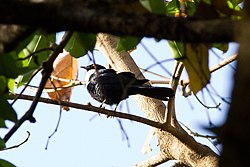Behavior
White-collared starlings are generally found in open woodland and seem to stay in the tops of high trees, but have also been reported in montane grasslands in Cameroon [8] They are known to feed on insects, berries, [7] wild figs and the fruit of musanga [5] and macaranga assass trees. [9]
They have been known to travel in pairs or small groups (4-10), [10] and in at least one case in a flock of more than 100 birds in June. Nest-building activity has been observed in March, and males collected at that time were found to have large testes; [11] these facts combined with the appearance of juvenile species between May and July suggest that breeding occurs in the first half of the year. In one instance, a male was seen to make short circular flights from a conspicuous pearch, which was interpreted as a courtship display. [6] [7]
This page is based on this
Wikipedia article Text is available under the
CC BY-SA 4.0 license; additional terms may apply.
Images, videos and audio are available under their respective licenses.

